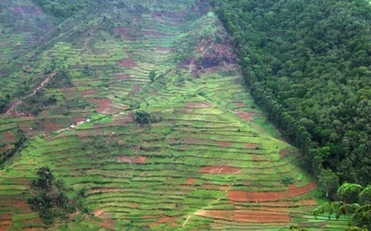Main Types of Habitat Loss
|
Navigation
|

The three main types of habitat loss are habitat destruction, habitat degradation and habitat fragmentation. As the late Steve Irwin put it, "I believe our biggest issue is the same biggest issue that the whole world is facing, and that's habitat destruction." Habitat loss is a serious problem for wildlife and humans alike. As Wildlife Habitat Canada states, "Without habitat, there is no wildlife. It's that simple." And without wildlife, there is no healthy functioning of the ecosystem services upon which we depend on.
|
|
Habitat Destruction
Habitat destruction occurs when natural habitats are no longer able to support the species present, resulting in the displacement or destruction of its biodiversity. Examples include harvesting fossil fuels, deforestation, dredging rivers, bottom trawling, urbanization, filling in wetlands and mowing fields. Learn more.
|
Habitat Degradation
A degraded habitat may remain intact, but it's degraded state may render it incapable of functioning properly and lead to species extinction or migration. The main causes of habitat degradation is pollution, invasive species, agricultural development, diminished resources, such as water and food, urban sprawl, logging, mining, destructive fishing practices and the disruption of ecosystem processes, such as altering the intensity and frequency of fires in an ecosystem. These are some of the ways habitats can become so degraded that they no longer support native wildlife. Learn more.

Acid rain, also called acid deposition, can cause habitat degradation. Acid rain is formed primarily by air pollution from nitrogen oxides and sulfur oxides released into the atmosphere when fossil fuels, such as coal and oil, are burned, which degrades habitats by causing precipitation to contain harmful amounts of nitric and sulfuric acids. These acids fall to the Earth either as wet precipitation, such as rain, snow, or fog, or as dry precipitation, such as gas and particulates. Some are carried by the wind, sometimes hundreds of miles. In the environment, acid rain causes the acidification of sensitive forest soils, streams, lakes and rivers, making the water unsuitable for some fish and other wildlife, contributes to the damage of trees by robbing them of nutrients, stifling new growth, killing many of the seedlings, making them more susceptible to other environmental threats and causing damage to the roots potentially leading to the trees death. Source: NYS Dept. of Environmental Conservation. Click for source.
|
Habitat Fragmentation
As the name implies, habitat fragmentation is the spatial separation of habitats from a previous state of greater continuity. The 'cutting up' of habitats into fragments is mainly caused by agricultural land conversion, urbanization, dams, water diversions, pollution, invasive species and deforestation, but can also be caused by geological processes that slowly alter the layout of the physical environment. According to NWF, "These fragments of habitat may not be large or connected enough to support species that need a large territory in which to find mates and food. The loss and fragmentation of habitat make it difficult for migratory species to find places to rest and feed along their migration routes," or to even make it across these ancient and essential migratory paths to begin with. Learn more.
|
"As buildings and roads take the place of forests, deserts, prairies, and savannah, and as human-made calamities threaten habitats, wild animals are forced into ever smaller and more crowded spaces. Around the globe, there is no greater threat to their survival. We can slow this trend and give animals the space they need. Animals are killed outright when the bulldozers move in. Those who can flee the destruction, face uncertain futures—if they can find a new place to live, it will probably already be occupied by others of their species. Populations are being fractured into smaller and smaller habitat patches, and we don’t yet know how this will affect biological diversity." ~The Humane Society of the United States
|
|
|
Last Revised: 11/20/13
Commenting Rules |



